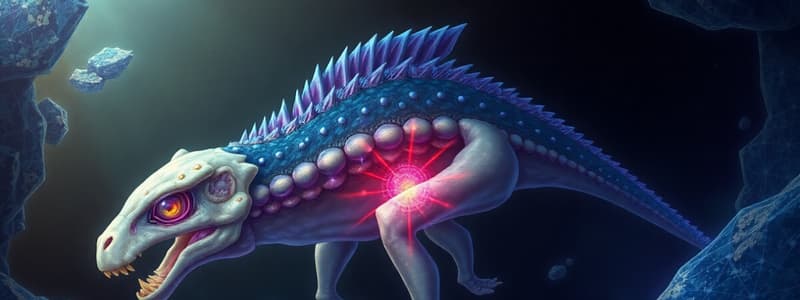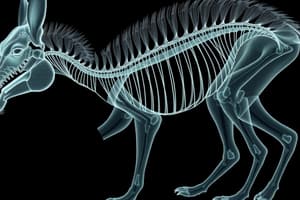Podcast
Questions and Answers
What is the main characteristic that distinguishes coelomates from acoelomates?
What is the main characteristic that distinguishes coelomates from acoelomates?
- Presence of scattered mesodermal pouches
- Presence of a notochord
- Presence of segmented bodies
- Presence of a body cavity lined with mesoderm (correct)
Which type of animal possesses a pseudocoelom?
Which type of animal possesses a pseudocoelom?
- Annelids
- Aschelminthes (correct)
- Molluscs
- Platyhelminthes
What is the term for animals that display external and internal body segmentation?
What is the term for animals that display external and internal body segmentation?
- Pseudocoelomates
- Coelomates
- Non-segmented animals
- Metameric segmentation (correct)
Which group of animals is defined by the presence of a notochord during development?
Which group of animals is defined by the presence of a notochord during development?
Which of the following is an example of an acoelomate?
Which of the following is an example of an acoelomate?
What defines a coelomate animal?
What defines a coelomate animal?
Which of the following is NOT an example of a coelomate?
Which of the following is NOT an example of a coelomate?
Which type of body cavity characterizes pseudocoelomates?
Which type of body cavity characterizes pseudocoelomates?
What is the primary characteristic of acoelomates?
What is the primary characteristic of acoelomates?
Which animal is a classic example of segmentation observed in coelomates?
Which animal is a classic example of segmentation observed in coelomates?
What is the primary function of the water transport system in sponges?
What is the primary function of the water transport system in sponges?
Which statement about sponges is correct?
Which statement about sponges is correct?
What type of cells line the spongocoel and canals in sponges?
What type of cells line the spongocoel and canals in sponges?
What distinguishes the larval stage of sponges from the adult form?
What distinguishes the larval stage of sponges from the adult form?
What materials typically make up the skeleton of sponges?
What materials typically make up the skeleton of sponges?
What unique structures do Cnidaria possess that allow them to capture prey?
What unique structures do Cnidaria possess that allow them to capture prey?
Which body form in Coelenterata is characterized as sessile and cylindrical?
Which body form in Coelenterata is characterized as sessile and cylindrical?
How do Cnidaria primarily reproduce in their polyp form?
How do Cnidaria primarily reproduce in their polyp form?
Which of the following is NOT a characteristic of Cnidaria?
Which of the following is NOT a characteristic of Cnidaria?
What is the role of the gastrovascular cavity in Cnidaria?
What is the role of the gastrovascular cavity in Cnidaria?
Flashcards
Coelom
Coelom
A body cavity lined by mesoderm.
Coelomate
Coelomate
An animal with a coelom.
Segmentation
Segmentation
Repetitive body parts in animals.
Pseudocoelomate
Pseudocoelomate
Signup and view all the flashcards
Acoelomate
Acoelomate
Signup and view all the flashcards
Body cavity
Body cavity
Signup and view all the flashcards
Mesoderm
Mesoderm
Signup and view all the flashcards
Coelom
Coelom
Signup and view all the flashcards
Coelomate
Coelomate
Signup and view all the flashcards
Pseudocoelomate
Pseudocoelomate
Signup and view all the flashcards
Acoelomate
Acoelomate
Signup and view all the flashcards
Metameric Segmentation
Metameric Segmentation
Signup and view all the flashcards
Notochord
Notochord
Signup and view all the flashcards
Chordate
Chordate
Signup and view all the flashcards
Non-Chordate
Non-Chordate
Signup and view all the flashcards
Coelenterata (Cnidaria)
Coelenterata (Cnidaria)
Signup and view all the flashcards
Cnidoblast
Cnidoblast
Signup and view all the flashcards
Polyp
Polyp
Signup and view all the flashcards
Medusa
Medusa
Signup and view all the flashcards
Gastrovascular cavity
Gastrovascular cavity
Signup and view all the flashcards
Alternation of generations (metagenesis)
Alternation of generations (metagenesis)
Signup and view all the flashcards
Asexual reproduction (Coelenterata)
Asexual reproduction (Coelenterata)
Signup and view all the flashcards
Radially symmetrical
Radially symmetrical
Signup and view all the flashcards
Tissue level of organization (Coelenterata)
Tissue level of organization (Coelenterata)
Signup and view all the flashcards
Sponges (Porifera)
Sponges (Porifera)
Signup and view all the flashcards
Water Canal System
Water Canal System
Signup and view all the flashcards
Ostia
Ostia
Signup and view all the flashcards
Spongocoel
Spongocoel
Signup and view all the flashcards
Osculum
Osculum
Signup and view all the flashcards
Choanocytes
Choanocytes
Signup and view all the flashcards
Intracellular Digestion
Intracellular Digestion
Signup and view all the flashcards
Spicules/spongin fibers
Spicules/spongin fibers
Signup and view all the flashcards
Hermaphrodite
Hermaphrodite
Signup and view all the flashcards
Asexual Reproduction
Asexual Reproduction
Signup and view all the flashcards
Sexual Reproduction
Sexual Reproduction
Signup and view all the flashcards
Indirect Development
Indirect Development
Signup and view all the flashcards




